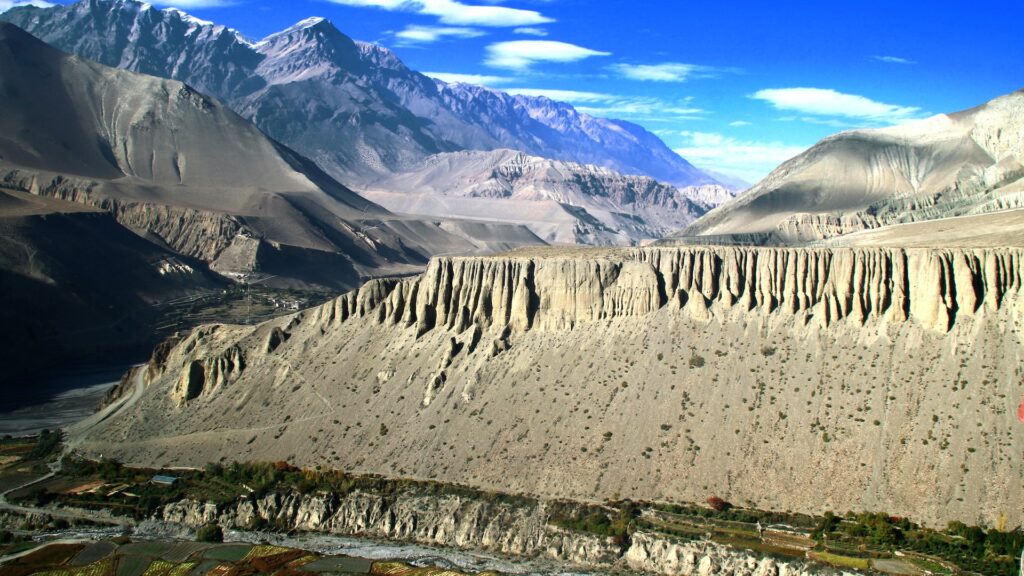Jomsom – Muktinath Trek
Jomsom – Muktinath Trek

Talk With Expert
- +977-1-5591234 / 9851104568
- info@prestigeadventure.com / pdamber@yahoo.com
OVERVIEW
The Jomsom trek is probably the single most popular trek in Nepal. The diverse landscapes and cultures to be found along the trek route give a marvelous insight into the way of life of rural Nepalese people. The main feature of trek is the walk through the George craved by the kali Gandaki River, which carries water from the Tibetan plateau to eventually join the Ganges in India.
Normally trekkers continue on above Jomsom to Muktinath, the famous pilgrimage site for both Buddhists and Hindus. To Hindus, Muktinath is sacred as the place of salvation. They believe that to wash in the waters here guarantees salvation after death. The Hindu god, Brahma, is thought to have lit the eternal flames that still burn at Muktinath. To the Buddhists it is a place that the great sage guru Rinpoche (Padmasambhava) meditated at, and to all, it is the source of fossilized ammonites, known locally as shaligrams, which are found all along the upper reaches of kali Gandaki.
Trek Facts
No. of days: 14
Mode of trek: Teahouse/Camping
Starting point: Jomsom
Ending point: Nayapul
Max. Elevation: 3817m
Season: Sept/Dec and Mar/May
Grade: Medium
Max. Walking: 6-7hrs.
Mode of travel: drive/fly in & fly or drive out
ITINERARY
-
Day 01 : Arrival Ktm, transfer to hotel BB
Once you are in the Kathmandu sky, you will be met by a panoramic vista of the snow-capped mountain ranges stretching below. At the airport, a representative from our office will greet you and drive you to your hotel. The representative will assist you in checking into the hotel of your choice. You will receive a briefing on your daily activities at the hotel. Hotel overnight stay.
-
Day 02 : Free day in Kathmandu, hotel BB
Since Nepal began welcoming tourists, Kathmandu, the historical and cultural center of the country, has become a well-liked travel destination. A beautiful fusion of Tibetan Buddhism, Hinduism, and Western influence can be seen in the city. A guided tour will be provided to three UNESCO World Heritage Sites: Boudhanath, the tallest Buddhist stupa in Nepal, Pashupatinath, the most well-known Hindu shrine devoted to Lord Shiva, and Patan or Lalitpur, also known as the City of Artists and located 5 kilometers from Kathmandu. You may marvel at the Malla era’s architectural marvels in Patan Durbar Square. The main attractions in the square are the Mahaboudha Temple, Kumbeshwor Temple, Krishna Temple, and Golden Temple. Hotel overnight stay.
-
Day 03 : Drive to Pokhara by private vehicle -6/7 hrs, and transfer to hotel in Pokhara
From the Kathmandu airport, it will take you 6–7 hours to drive to Pokhara. Once in Pokhara, a transfer will take you to your hotel. You can spend the remaining time of the day exploring Pokhara Bazaar, shopping, or boating in Phewa Lake.
-
Day 04 : Drive to Birethati (1100m) in about 2 hours; then, hike through Birethanti in about 5 or 6 hours to Ulleri (2000m).
You may reach the trailhead at Birethanti, a bustling community of lodges, stores, and homes, after a quick drive of around an hour. Your walk through the Annapurna Base Camp walk trail starts with a moderate elevation along the BhurungdiKhola’s left bank. After that, you leave the river and travel via Hille to Tikedungha along a trail that runs along the upper edge of terraced farms. After leaving the settlement, you must cross a creek before arriving at the suspension bridge across the BhurungdiKhola. The Ulleri settlement is reached after ascending a protracted, winding stone staircase that seems to go on forever. This town offers beautiful views of Hiunchuli and Annapurna South.
-
Day 05 : Trek to Ghorepani
You can find Annapurna South, which is concealed by a ridge, as you climb the path that goes to a forest. Beautiful oak and rhododendron forests can be found beyond Banthanti. You reach the settlement of Nangathanti after navigating a number of crystal-clear mountain streams. After several more hours of woodland trekking, you arrive in Ghorepani. Ghorepani, which means “horse water” in the literal sense, is a well-liked rest stop for mules that travel this route from Pokhara to Jomsom and beyond. You may reach a little pass and the settlement of Deorali after a ten-minute stroll. You take a nap at Ghorepani to allow for adequate acclimatization.
-
Day 06 : Trek to Tatopani
You rise early to climb to Poonhill for a spectacular view of the sunrise from a prime location. After breakfast, you descend to Tatopani amid the breathtaking natural landscapes via the rhododendron forest. You get a breathtaking glimpse of the Dhaulagiri mountains as you come closer to Chitre. The route then passes over terraced fields on its way to Sikha, a Magar settlement perched atop a ridge. Continue to descend, first softly and then more sharply, until you reach the GharKhola. It is only a short distance upstream to Tatopani after you cross the Kali Gandaki on a big suspension bridge following a short climb. Tatopani’s name derives from the hot springs that are close to the river below the settlement.
-
Day 07 : Trek to Ghasa
The trail that gently climbs the world’s deepest valley, the Kali Gandaki valley, must be followed in order to reach the settlement of Dana, which is encircled by orange trees. Along the way, you pass locals selling oranges in baskets when the season is right. A roaring waterfall thunders down alongside the trail just past the tiny village of Rupse. The steepest and smallest part of the gorge is then reached via the trail. The spacious and well-built layered stone path will impress you. You turn toward Ghasa, a small Thakali settlement, as the granite cliff ends. In Ghasa, there are numerous homes with flat roofs.
-
Day 08 : Trek to Larjung
You trek from Ghasa to Larjung after breakfast. A few hours of descents quickly follow additional rocky ascents through fir, cypress, and juniper forests along the Kali Gandaki riverside. As soon as you arrive in Larjung, you cannot help but be amazed by the architectural splendor of this small town; tunnels, congested streets, and buildings constructed in the old-fashioned manner make for an intriguing sight.
-
Day 09 : Trek to Jomsom
You start your ascent along the path that skirts the Kali Gandaki’s broad valley, passing through Khobang and Tukuche. Once more, you may witness dwellings constructed around private courtyards to shield from the blustery winds of the Kali Gandakigorge. The trail continues to meander through orchards with stone walls. You soon arrive to a stone gate that serves as Marpha’s entryway. Numerous homes with white walls are visible. Marpha is highly known for its native apple brandy and has a well-kept drainage system. You continue your journey after Marpha’s lunch by hiking toward Jomsom to meet the Annapurna Circuit trail. The terrain grows more dry and stunning as you get closer to Jomsom, with its mixture of brown, yellow, and grey standing out against the white snowcapped mountains.
-
Day 10 : Trek to Muktinath
Following breakfast, you continue your hike along the trail up to the Kali Gandaki’s extensive gravel riverbed. You come upon lush foliage and a creek. Following a brief ridge crossing to ChhanchaLhumba at 2730 meters, you continue traveling in the direction of Muktinath. The view is dominated by Dhaulagiri and Nilgiri as you make your way up to Khingar (3200m). As the trail ascends to Jharkot (3500m), more meadows, streams, and beautiful foliage may be seen along the way. You come across the Dzong’s remains together with the spotless villages of Purang and Changur. You enter Ranipauwa as you make your way past mule stalls and a rocky, barren mountainside. For many years, Ranipauwa has been a popular resting place for pilgrims and visitors. You reach Muktinath after more hiking. The main religious buildings are temples and shrines.
-
Day 11 : Trek to Jomsom
As you leave Muktinath, you turn back toward Jomsom while taking in the breathtaking scenery of the Nilgiri mountains. Your overnight stay is in Jomsom. With the crew, whom you have gotten to know so well over the last seven or eight days, you celebrate the end of your unforgettable Annapurna journey in the evening.
-
Day 12 : Fly to Pokhara in 20 minutes, then explore Pokhara.
You take a 20–25 minute flight early in the morning to Pokhara. It offers breathtaking views of the Dhaulagiri and Annapurna mountains as it soars over the Kali Gandaki Gorge. After that, you’ll embark on a city tour. You will go to some of Pokhara’s well-known attractions, including the Devis Waterfall, Seti Gorge, Bindabasini Temple, and Guptseshowor Cave.
-
Day 13 : Fly to Kathmandu (also as a backup plan)
You’ll fly to Kathmandu for around 30 minutes. You will get breath-taking views of Mounts Annapurna, Machhapucher, and Manaslu while in the air. Once in Kathmandu, you will be transferred to a hotel.
-
Day 14 : Final departure
Up until the time of your departure, you are free to indulge in souvenir buying, sightseeing, or other private pursuits. You will be driven to the airport in preparation for your return trip.
COST
WHAT IS INCLUDED
-
- 04 nights hotel in Kathmandu & 02 nights hotel in Pokhara in 3 star standard on BB.
- Flight Ktm – Pookhara – Jomsom & Pokhara – Ktm.
- All meals (Breakfast/lunch/dinner with tea\coffee).
- Accommodation in teahouses.
- A guide.
- Ground transportation.
- Entry permits.
- All necessaries for Nepalese staffs (all meals, accommodation in tea houses, equipment’s, insurance).
WHAT IS EXCLUDED
-
- Lunch / dinner in Ktm & Pokhara stay.
- Any bar bills (alcoholic drinks, mineral water, cold drinks).
- Cigarettes.
- Clients personal insurance.
- Any kind of unforeseen expenses.
- Sleeping bag.
- Down jackets.
- Airport tax (Domestic / International) emergency rescue flight & expenses if require, etc.

